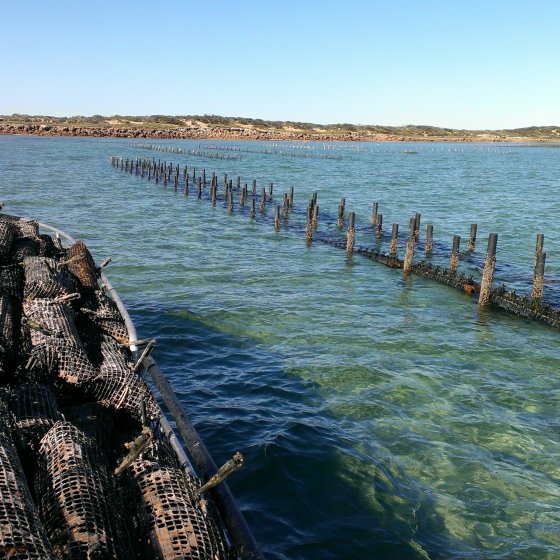- Home
- Environmental Themes
- Sea
- Pressures and Responses
- Pests and Diseases
Pests and Diseases
Movement of Vessels and Infrastructure
Pressures
- Vessel use and movement (both commercial and recreational) including dredging equipment. There has been a 50% growth in coastal shipping between 1970–71 and 2018–19 in Australia.
- Movement of aquaculture stock and equipment.
- Dredging activities involving introduction of infrastructure and placement of dredge spoil onto another location.
Impacts
- Introduction of pests and diseases into an unaffected area by translocation from one location to another. This may result in an increased risk of disease transfer to wild endemic populations and/or the potential for pest species to outcompete native species.
- Pacific Oyster Mortality Syndrome (POMS) was detected in feral oysters in the Port River in February 2018. The introduction of POMs into our oyster growing regions would have a devastating impact on our oyster industry as it causes rapid death and high mortality rates in farmed Pacific oysters, up to 100% within days of being detected. POMS can also spread quickly if introduced.
- Wakame (Japanese seaweed) was detected in marinas in the South East in winter 2023.
- Introduction of species from one location to another may also modify existing gene pools of endemic populations.
Responses
- Moving (translocation) of aquatic animals is regulated by PIRSA under the Fisheries Management Act 2007 to protect South Australian fisheries and aquaculture industries and the environment. PIRSA undertakes an assessment of proposed aquaculture species to assess potential biosecurity risks and impacts to local gene pools.
- PIRSA has implemented measures to minimise the potential for POMS to be translocated to the oyster-growing regions through restrictions in moving aquaculture equipment from Tasmania.
- PIRSA has provided guidance on what must be considered to address biosecurity risk associated with pests and diseases during dredging.
- Development of a new Biosecurity Bill by the South Australian Government to provide a more flexible and responsive framework and improve consistency for the management of biosecurity across industries in South Australia.
- The EPA dredge guideline also highlights the potential biosecurity risks associated with dredging.
Opportunities
- Identify and implement further measures to reduce risk of POMS moving from the Port River, especially to the oyster-growing regions within South Australia.
Ballast Water
Pressures
- Discharge of ballast water and removal of biofouling from vessels.
Impacts
- Introduction of aquatic pests and diseases that may reside on the hull of vessels and be discharged in ballast water or removed during in-water hull cleaning.
- Introduction of pest species and diseases from overseas.
Responses
- Advice for management of biofouling and ballast water is provided by PIRSA to minimise the introduction or spread of marine pests and diseases.
- The Australian Government, through the Department of Agriculture, Fisheries and Forestry, also specifies requirements for management of biofouling including ballast water and in-water cleaning of hulls.
- The Australian Ballast Water Management Requirements set out obligations for ballast water management in Australian waters.
Human Activities
Pressures
- Use of diseased bivalves and crustaceans as fish berley.
- Introduction of cats (including feral), dogs and foxes into sensitive coastal areas.
Impacts
- Introduction and spread of diseases, eg POMS, and white spot disease in prawns. This would have devastating impacts on the oyster industry and the prawn fishery.
- Impacts to native birds and animals that live in sand dunes and the beach.
Responses
- Information and education provided to recreational fishers and consumers on how they can help keep South Australia free of disease.
- Dogs must be on leash in some areas.
Opportunities
- Expand education to general community of the risks of using prawns and oysters for berley or throwing byproducts back into the ocean.
Further Reading
- The National Priority List of Exotic Environmental Pests, Weeds and Diseases – provides a list of exotic species of significant environmental and social amenity risk to Australia. This list includes marine pests and aquatic animal diseases.
- Marine Pests – Information from the Australian Government on identification and management of marine pests in Australia.
- CSIRO Marine pollution – Sources distribution and fate of plastic pollution in the marine environment.
- Shellfish reefs in Australia – Information on the construction of shellfish reefs and the benefits they provide.
- FRDC Biosecurity – Support in research on biosecurity risks in Australia.
